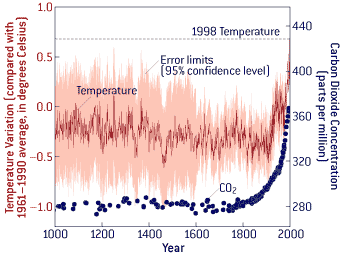Climate of Uncertainty
THE UNKNOWNS IN GLOBAL WARMING RESEARCH DON'T HAVE TO BE SHOWSTOPPERS
|
. |
Denying uncertainty makes life so much easier, as many have discovered when it comes to climate change. Between skeptics' insistence that global warming is just hot air and radical environmentalists' advice to start selling the beachfront property, responses to climate change tend to be predicated on claims of absolute knowledge. Who wants to deal with the messy reality? There is plenty of evidence that temperatures are rising and will continue to do so but lots of uncertainty about the details and amount of future change. The good news is that politicians are finally confronting the messiness. Following the environmental summit this past July in Bonn, Germany, every nation but one is pressing ahead with the Kyoto Protocol, which caps industrialized countries' output of greenhouse gases. The U.S. is pressing ahead with a close approximation to nothing, although on June 11 President George W. Bush stated, "I've asked my advisers to consider approaches to reduce greenhouse gas emissions." A policy could materialize by the next summit this month in Marrakech, Morocco. Already some 31 resolutions, amendments and bills--from endorsements of Kyoto to modifications of the Clean Air Act--are kicking around Capitol Hill. The bad news is that uncertainty still paralyzes discussion, especially in the U.S. Scientists naturally generate a range of results. Not all of these results are equally likely to be true, and none is definitive, but people tend to latch onto those that suit their preconceptions.To inject some rigor into the debate, the latest Intergovernmental Panel on Climate Change (IPCC) report adopted a consistent set of terms to convey how much confidence researchers had in their conclusions, ranging from "virtually certain" to "exceptionally unlikely." But climatologist Stephen Schneider of Stanford University and economist John Reilly of the Massachusetts Institute of Technology and his colleagues contend that the IPCC didn't go far enough. In particular, it failed to express the likelihood of predictions that the global temperature would rise by 1.4 to 5.8 degrees Celsius by 2100. That widely quoted range looks like an error bar--a span of values with a well-defined probability of encompassing the true value--but it is actually just a grab bag of model results. "I'm very worried about chicanery," Schneider says. "I'm worried about people grabbing these IPCC numbers and then going out there and saying, ?Oh, it's only going to warm up by one degree,' and somebody else saying ?It's going to warm up by six.'" Last year Myles R. Allen of the Rutherford Appleton laboratory in Didcot, England, and his colleagues took the first stab at quantifying the probability. They reasoned that the response of the climate to perturbations (such as adding greenhouse gases) is nearly linear, at least over the short haul.
Much the same numerical result emerged from a complementary approach described in the July 20 Science. Two teams--Reilly's group and Tom M. L. Wigley of the National Center for Atmospheric Research and Sarah C. B. Raper of the University of East Anglia--systematically varied parameters in simplified climate models. Unlike the historical approach, this method could evaluate the probability of effects that haven't yet manifested themselves. On the other hand, the simplified models might omit something crucial. They are used because full-blown models are too computationally intensive, a limitation that researchers are now working to overcome. These quantitative analyses transform the yes-no debate over global warming into an actuarial decision: probability times expected damage equals how much we should spend now on mitigation. But putting that principle into practice might require changes to Kyoto. The protocol does not specify how much money nations should pay to limit gas emissions. That brings up the other great uncertainty about climate change: the economics. Although Kyoto explicitly aims to minimize the burden of emissions control by using market-based incentives rather than government intervention, nobody knows for sure how much curtailing greenhouse gas production will cost. It could yield a net benefit (for example, by improving energy efficiency), or it could stop the economy cold. Yet prominent critics of the protocol--notably economist William Pizer of Resources for the Future, a Washington think tank, and political scientist David G. Victor of the Council on Foreign Relations--have argued that the best response isn't to deep-six Kyoto but to add a safety valve. If emissions reductions ever got too expensive, governments would allow companies to emit more carbon dioxide by paying a flat rate per ton. That idea gives environmentalists the shivers, but by making nations more willing to participate, it may well clear the way for deeper reductions. Last year climatologist James E. Hansen of the NASA Goddard Institute for Space Studies and his colleagues championed another way to cut costs: shift the onus from carbon dioxide to other heat trappers, such as methane, that are more potent, more threatening to local air quality and less crucial to economic activity. Kyoto already puts more weight on methane than on carbon dioxide, but is that enough? As economists Alan S. Manne of Stanford and Richard G. Richels of the Electric Power Research Institute discuss in the April 5 Nature, it isn't an either-or question. Even though carbon dioxide is less insulating than methane, it stays in the atmosphere longer, so we may want to get cracking on it right away. Reilly, who has done similar work, agrees: "We can save methane abatement until we need a quick, short-term fix." The tragedy is that President Bush's outright dismissal of Kyoto has so alienated other countries that it would be hard to muster support for modifying the protocol. "If the administration knew what it wanted to do, then the time to build a coalition in favor of that would have been before Bonn," Victor says. "The U.S. blew an opportunity." |
--By George Musser
